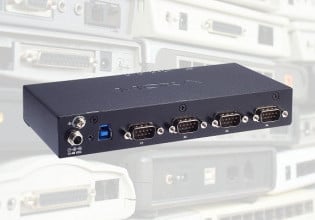New IO-Link Connectivity at the Edge From Hilscher
Hilscher has released a new IO-Link master device for connecting both legacy devices and new smart sensors to Industry 4.0 infrastructure at the edge of the physical factory floor.
Hilschner, a leading supplier of industrial communications solutions, has recently announced the release of its latest IO-Link master. The device is designed to help end users integrate IO-Link sensors into an Ethernet-based IT infrastructure. Hilscher has managed to make this possible with a minimal amount of communication network disruption.
There are two different options available to customers, the sensorEDGE FIELD and the sensorEDGE. Both devices can be controlled via a central platform or a web interface for configuration and management. Both are designed to incorporate the network of IO-Link devices into a single higher-level network system. The sensorEDGE FIELD features a secure application system and is encapsulated via container technology to help protect user data and ensure efficient communication with cloud systems.
Hilschner hopes the new systems will ensure users have access to a combination of computing power and standardized IO-Link sensor connection capabilities in a single device.
The sensorEDGE FIELD
The sensorEDGE FIELD from Hilschner is a versatile option for more advanced automation users to connect IO-Link capable sensors with upper-level cloud and data management systems. This can help to further integrate Industry 4.0 infrastructure into plant processes. The IO-Link-master can connect with up to eight different IO-Link-based sensors providing an instant solution for monitoring IO-Link devices. In addition to the 8x IO ports, an Ethernet uplink port gives the device connection to upper-level infrastructure. The device is built with IP67 certification and features a small footprint to help free up cabinet space.

The sensorEDGE FIELD comes with an edge computing system. Image used courtesy of Hilscher
The box runs its own operating system (a version of Linux), aggregating data and making it available as MQTT messages, a standard messaging protocol for IIoT systems. The MQTT broker can be moved directly to the device through the use of an internal edge computer in conjunction with container technology.
The edge computing system allows the device to function independently of a separate control system, and it can detect sensors when they are connected without complicated configuration. The sensorEdge FIELD gives users the ability to connect new and legacy equipment to Industry 4.0 technologies with a minimum amount of extra hardware and converters.
The sensorEDGE
The more simplified sensorEDGE is also capable of connecting up to eight different IO-Link ports and one Ethernet uplink port in its IP67-rated housing. It provides users with legacy equipment an option to upload data directly to the cloud at minimum intervals. Upload speeds are on the order of once per second. The system is easy to set up and can be integrated by simply plugging the device into the network.
Once the sensors are plugged in, the device can automatically configure them through the use of an IODD (I/O device description), usually available from an internet file database or from the manufacturer. The next step, visualization of the data, is made available through a corresponding cloud web frontend or with the use of an API from any third-party application.
SensorEDGE is a great candidate for legacy equipment that has traditionally been controlled locally and never had the infrastructure to be monitored remotely. It is also compatible with IO-Link sensors that use protocol standard IEC 61131-9 for easy integration.






